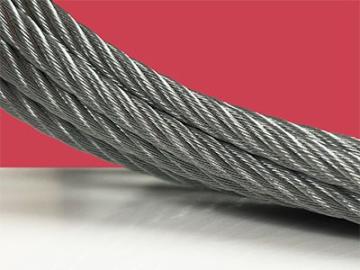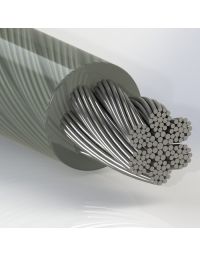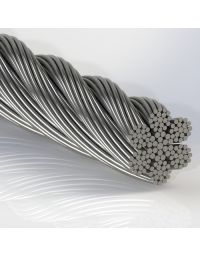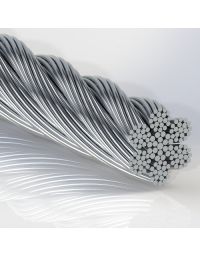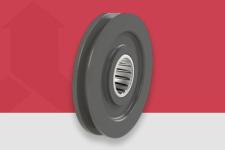Aircraft cable is mostly produced using AISI 304 and AISI 316 austenitic grade stainless steel, the latter of which includes molybdenum for greater corrosion resistance. What’s interesting however is that most cable and wire rope, terms with different meanings discussed later in this article, are produced from the same two grades of stainless steel as well. Therefore, no chemical compositional difference exists between aircraft cable and other varieties of stainless steel cable and wire rope. What’s more, galvanized steel aircraft cable, a more cost-effective alternative to stainless steel aircraft cable, is likewise indistinguishable from any other galvanized steel cable or wire rope too.
So why the distinction? Why, in other words, call stainless steel cable, “aircraft cable,” if the two products are interchangeable?
The answer is size.
You see, aircraft cable unintentionally emphasizes the term, “aircraft,” as if to suggest it is in the product’s use in aircraft that a distinction exists. The truth is far simpler, however. Yes, aircraft cable is meant for aircraft applications. But the term, “aircraft cable” ignores that the operative distinction in this variety of cable product resides in the term, “cable,” and not at all in the word, “aircraft.”
Wire rope, for instance, is the term used to describe mechanical cable produced in diameters >.375” (9.525mm), while, “cable” or, if you wish, “mechanical cable” are both terminology used to characterize cable in diameters <3/8”. So, Aircraft cable is recognized as such when it is produced in diameters ≤ 3/8” and in use in aircraft applications. Carl Stahl Sava Industries, by way of further example, offers aircraft cables in diameters ranging from .0312" - .375" (.79 – 9.53 millimeters).
Explore Sava's Entire Line of Aircraft Cable/Wire Rope
Trust our 50+ Years of Manufacturing Expertise
Aircraft Cable Common Use Cases
Aircraft cable supports a wide array of aircraft systems. Those most common include:
- Control Cables: often called push-pull cable, or in Europe it’s called, Bowden cable, these sophisticated aircraft cable assemblies allow the pilot to transmit motion and force across a distance. Take a Cessna Skyhawk’s throttle system, for instance. Pushing forward on the throttle knob, from the pilot’s instrument panel, forces more fuel into the engine, resulting in a burst of increased power to the engine. This results in faster propeller revolutions, which accelerates the aircraft. The aircraft cable powering this throttle system provides the pilot with an effortless gradient of power input and feedback, permitting aircraft power to be a mere fingertip away. Even more, aircraft cables, of the control cable variety, are also used for other critical flight controls, such as the aircraft’s rudder, ailerons, and elevators.
- Landing Gear Cables: Like the throttle example, the landing gear systems inside aircraft commonly use push-pull aircraft cables as well. Once again, from the comforts of the cockpit, the pilot actuates the aircraft’s landing gear with a button, lever, or knob. And far further away from the pilot’s seat, aircraft cables are pushing/pulling the corresponding motion control landing gear components into position.
- Antenna Lines: Radio and other communications systems that depend upon sensitive antennas can oftentimes be periscopic, telescopic, or in some other way retractable in functionality. When this is the case, aircraft cables once again, acting in a push-pull capacity, allow the pilot to actuate communications systems that operate within cable-driven motion control systems.
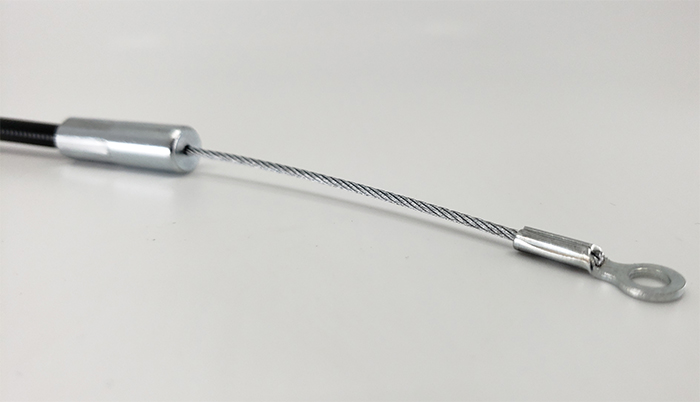

Wire Materials for Aircraft Cable
Stainless Steel Aircraft Cable
As mentioned, stainless steel is the most frequently used alloy in the manufacture of aircraft cable. As also discussed, this is so because of stainless steel’s strength and resistance to corrosion amid harsh environmental surroundings like those containing salt water or other forms of oxidation.
Galvanized Steel Aircraft Cable
In some cases however, stainless steel can be more than the aircraft cable application necessitates. When deployed in less hostile environments, aircraft cable produced using galvanized steel therefore provides an adequate defense against corrosion, while also satisfying rigid factors of safety and even reducing manufacturing costs.
Although, it is important to recognize that while a savings is realized in choosing galvanized steel aircraft cable, galvanized steel is, by its very nature, coated in a thin layer of zinc, which is how the exposed steel beneath the zinc is protected against corrosion. And so even though galvanized steel aircraft cable possess good corrosion resistance, as well as excellent ductility, the thickness of the zinc coating typically ranges from 70 to 150 micrometers (µm), which is no greater than the thickness of two or three strands of human hair -- roughly between 0.07 to 0.15 millimeters.
This thin protective layer of zinc increases the aircraft cable’s risk of damage due to exposure. Even the most incidental blemishes, scratches or abrasions made to the zinc can compromise the protective properties of the aircraft cable, rendering it defenseless against corrosion and other forms of deterioration. Given these considerations, aircraft cable produced using galvanized steel are typically relegated to control system applications that never risk being exposed to abrasion, salt water or other forms of threatening condensation.
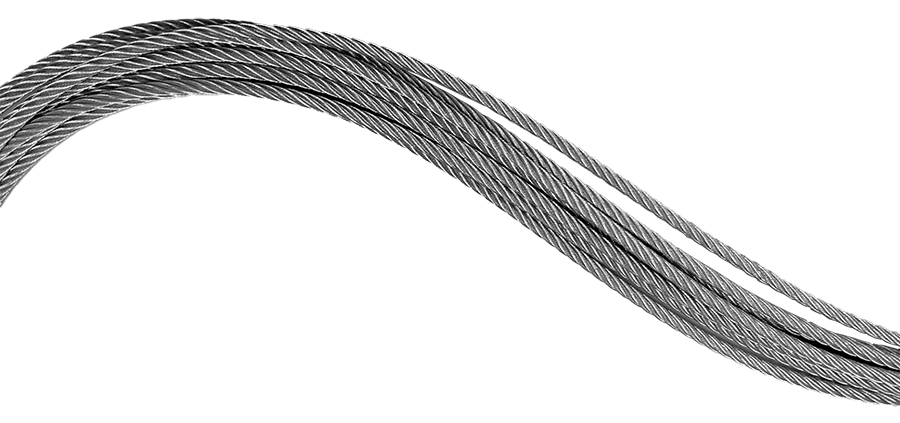

Coated Aircraft Cable
Coated Aircraft cable is very simply stainless steel cable or galvanized steel cable coated, most regularly, in a layer of either PVC (vinyl) or nylon (also known as polyimide or PA). Though it is important to note that there are many other coating types, PVC and nylon are the two most commonly used in aircraft cable applications.
Coated aircraft cable, among its more obvious benefits, like shielding the cable from dust, moisture and other caustic particles, generally increases the working life of the aircraft cable by between 300% and as much as 1,000%. For this reason alone, it is plain to see why many aircraft cables are coated.
Nylon Coated Aircraft Cable
The benefits of nylon coated aircraft cable largely deal in its high abrasion resistance. Its exceptional ability to tolerate abrasive forces translates into prolonged fatigue resistance as well. This cause-and-effect scenario yields the cable a long, reliable lifespan. Additionally, nylon possesses a moderate temperature tolerance, making it suitable for most aircraft operating temperatures.
However, nylon does come with some tradeoffs.
For instance, its low UV resistance means it’ll degrade quicker than other coating types when directly exposed to sunlight. Nylon is also less flexible than PVC, leaving this variety of aircraft cable stiffer as it makes its way around a sharp radius. Lastly, nylon is also more expensive than PVC.
Combined, nylon coated aircraft cable offers the aircraft in which it is deployed a durable workhorse that won’t wear quickly, but will also increase costs and offer less geometric flexibility.
PVC Coated Aircraft Cable
Comparatively speaking, PVC, also known as polyvinyl chloride, offers excellent UV protection, when measured against nylon. But PVC also possesses a lower tolerance to abrasion and fatigue. So, while PVC aircraft cable will perform better under direct sunlight, it will fare worse where abrasive forces are constant. PVC can, however, shoulder higher temperatures, making it an ideal aircraft cable option where protracted exposure to extreme temperatures are present. Less expensive than nylon, PVC is often found in push-pull control cable applications, which as mentioned previously, are among the most common use cases for aircraft cables.
Nylon vs. PVC Coated Aircraft Cable: Property Comparison
| Property | Nylon | PVC |
|---|---|---|
| Abrasion resistance | High abrasion resistance | Lower abrasion and fatigue tolerance |
| Temperature tolerance | Moderate temperature tolerance | Higher temperature tolerance |
| UV resistance | Low UV resistance | Excellent UV protection |
| Flexibility | Less flexible | More flexible |
| Cost | More expensive | Less expensive |
Common Wire Rope Constructions for Aircraft Cable
All cable and wire rope constructions are defined by the quantity of wires used to produce them. Therefore, aircraft cable constructions are likewise defined in the same way. But not just any cable construction qualifies as aircraft cable due to both flexibility considerations, as well as those centering on the strict factor of safety all cables must achieve before they can safely, reliably perform their function. Given this article discusses aircraft cables, any failure to support a designated load, or exhibit the flexibility required, could result in as little as equipment failure or damage, but as much as a loss of life.
To ensure a rigid factor of safety is met, and the cable satisfies its flexibility requirements, not all cable constructions can qualify as aircraft cable because, for instance, it the cable did not possess the quantity of wires necessary to support its load, or it was too rigid to make tight turns, it would fail in the field. Furthermore, if fewer wires can support a required load, and do not compromise flexibility, but introduce larger wire diameters, weight and formfactor can become challenges, because, as stipulated, aircraft cable is designed small to allow for low-weight, high-strength prerequisites to each be satisfied.
Also citing the small, confined spaces aircraft cables typically occupy it becomes even easier to understand why not all cable construction are worthy of the moniker, aircraft cable.
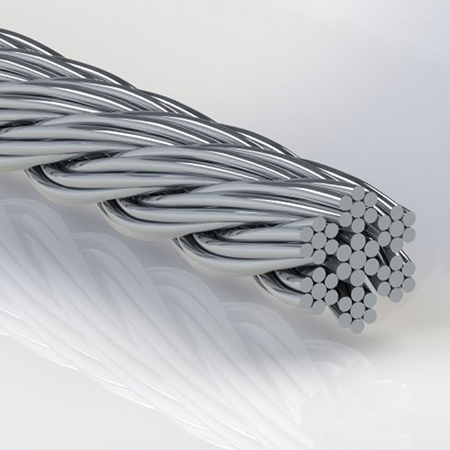

7x7 Aircraft Cable
Take, for instance, a 7x7 aircraft cable construction. In this configuration, the cable’s development begins with seven individual wires: one core wire, wrapped helically in six additional wires. By itself, this construction is known as a 1x7 construction because a single wire is wrapped in six more wires.
Taken alone, a 1x7 cable construction, known at this stage as “strand,” may not be worthy of being labeled aircraft cable because, a 1x7 is known for its springy, more inelastic behavior. To achieve the flexibility the aircraft cable undoubtedly requires, the 1x7 strand is therefore wrapped in six additional 1x7 constructions, which yields the cable maker a 7x7 aircraft cable construction -- or a cable comprising a total of 49 wires: an extremely flexible cable construction.
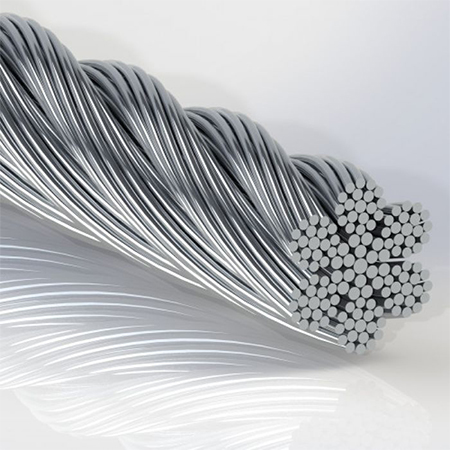

7x19 Aircraft Cable
Similar in stages to the 7x7 aircraft cable, a 7x19 aircraft cable begins with a core wire, wrapped – in a helical pattern – by an additional six wires. However, unlike the 7x7 aircraft cable, this newly stranded 1x7 material is subsequently wrapped in an additional 12 wires, producing a 1x19 cable construction.
From here, this 1x19 stranding process is duplicated and ultimately, a total of six additional 1x19 strands are wrapped around the initial 1x19, yielding the cable maker a 7x19 aircraft cable construction – or a cable comprised of a total of 133 wires. Quite flexible, durable and in stainless steel, possessing superior corrosion resistance.
Concerning its factor of safety, Sava suggests that stationary cable should achieve a minimum factor of safety of 3.5:1. However, factors of safety are defined on a case-to-case basis and therefore can reach as high as 8:1, 10:1, or greater, where the application requires it.
It is critical to note that additional quality testing should be performed to ensure the exact factor of safety, on an individual, case-to-case basis, is met.
Speak to an Aircraft Cable Expert
Aircraft cable is mechanical cable no larger in diameter than .375" (9.53 millimeters). And although aircraft cable masquerades as any other wire rope or small mechanical cable, aircraft cable must possess both the strength and flexibility required to perform demanding tasks, without failure, within extremely tight spaces. Even more impressive, these seemingly ordinary cables must likewise be strong and malleable enough to satisfy a stringent factor of safety, while assuming a diminutive footprint, as they effortlessly twist through the nerve center of the aircraft.
With so much at stake, it’s critical to speak with a cable expert about your aircraft motion control application. Sava’s engineering team comprises authorities on the manufacture of aircraft cables and can ensure, for the very first discussion, that you are outfitting your systems with the world’s best aircraft cable solutions®.
Talk to our team today and make sure your aircraft cable project soars.

